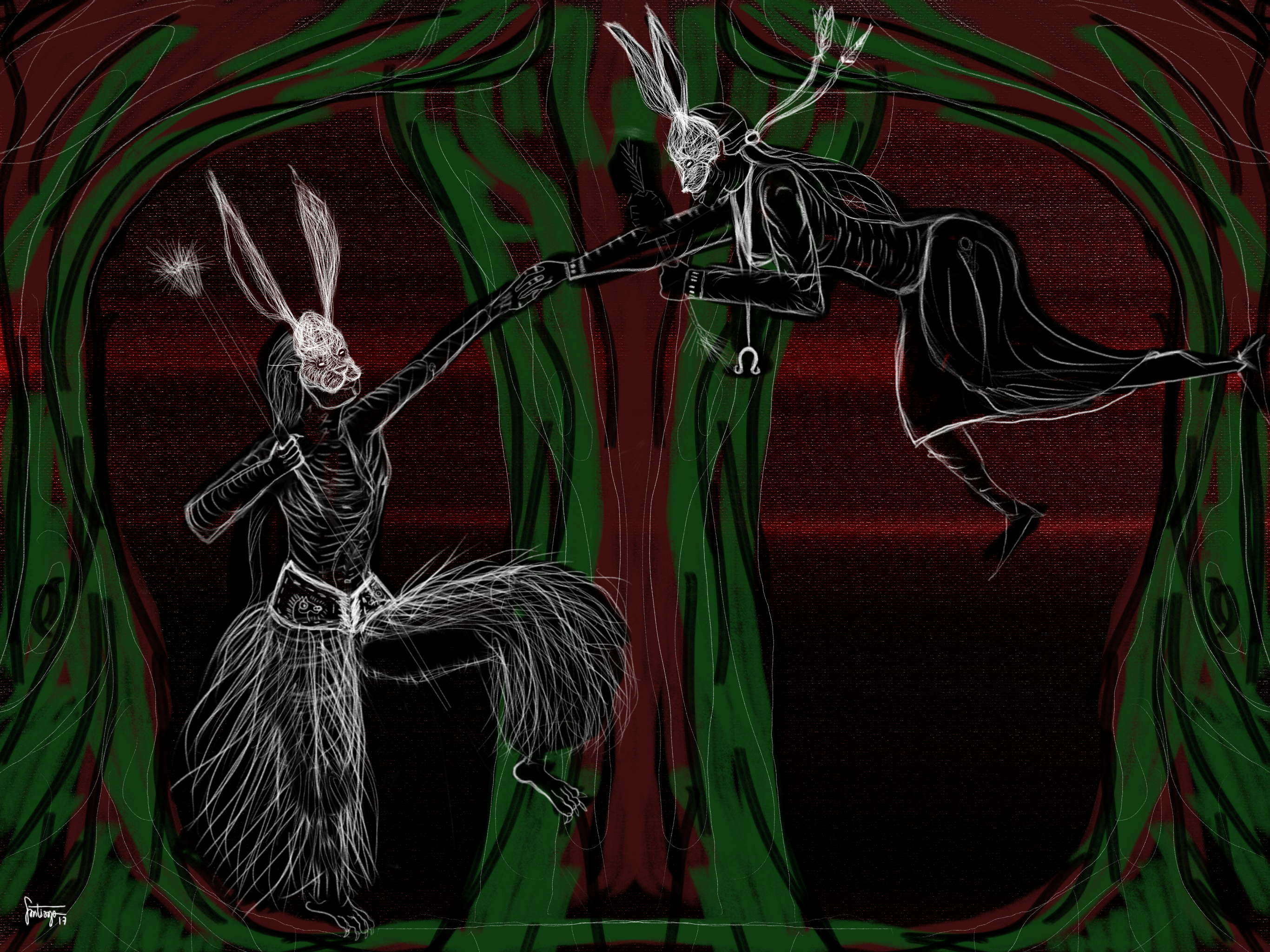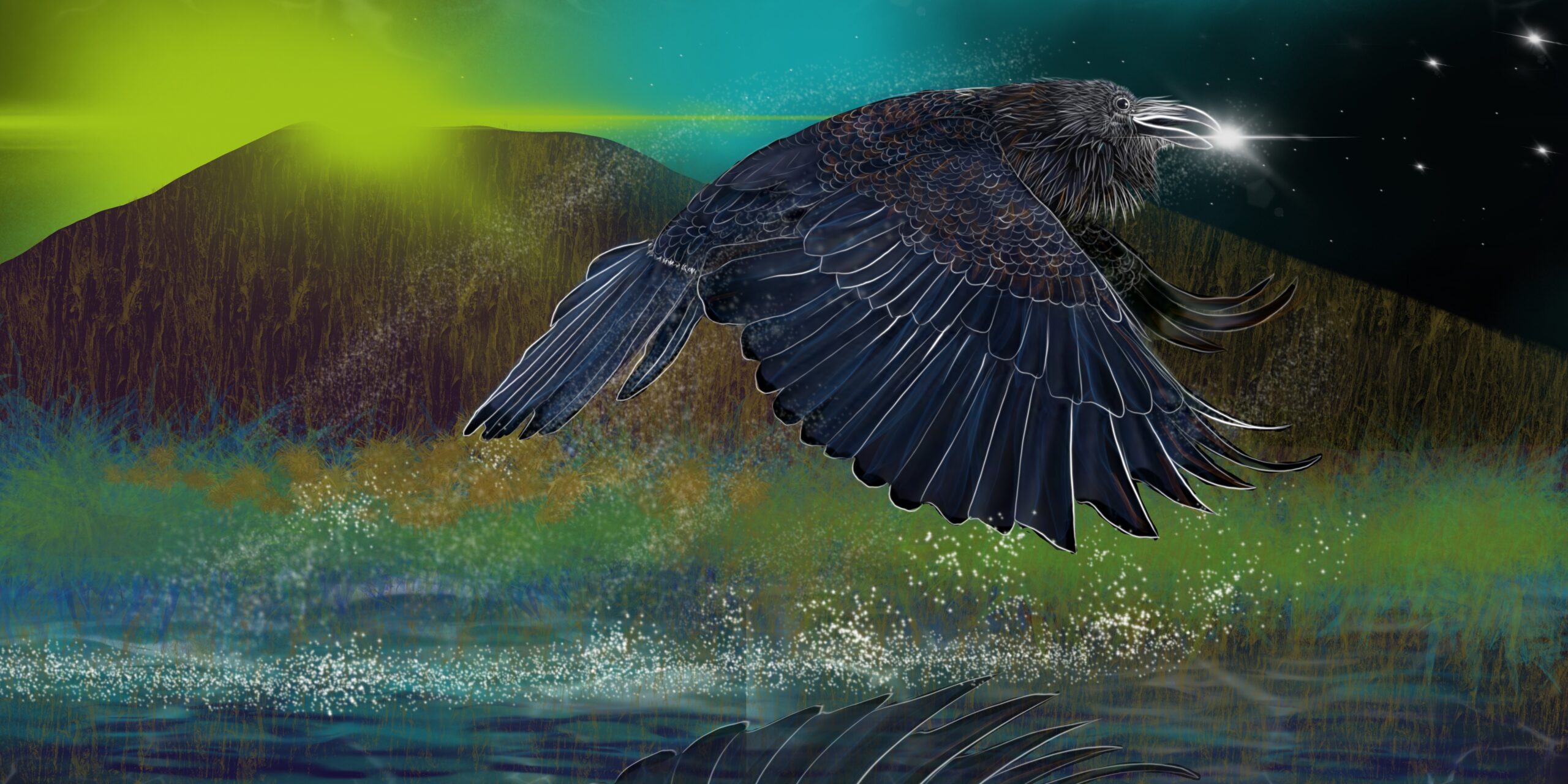El despertar de Taita Cuervo
Por Santiago Andrade León
Mucho antes de que el fuego cantara en las montañas, mucho antes de que los ríos pudieran recordar sus nombres, reinaba el silencio.
Era el tiempo de la Muerte, que enseñaba quietud y enseñaba olvido.
En ese tiempo sin tiempo, dentro de un huevo profundo y oscuro, dormía Taita Cuervo. Su sueño era denso, como la raíz bajo la tierra, pero su corazón palpitaba con preguntas.
—¿Quién vive aquí? —susurraba Taita Cuervo desde adentro del cascarón.
Y desde el abismo, miles de voces le respondían:
—Yo.
—Solo existo yo —pensaba entonces, y se acunaba en el eco de su propia existencia.
Pero un día, una voz nueva, una voz que venía desde fuera, golpeó su sueño:
—¿Quién está afuera? —preguntó Taita Cuervo.
—Yo —respondió la voz misteriosa.
Y luego, la voz preguntó también:
—¿Quién está adentro?
—¡Yo!—respondió Taita Cuervo, agitando sus plumas invisibles.
El huevo comenzó a temblar. Toc, toc, toc…
Taita Cuervo respondió al llamado:
—¡Toooc, toooc!
Y la respuesta llegó de afuera:
—¡Tooc, tooc!
El cascarón crujió, y una chispa de luz penetró la oscuridad.
—¿Quién eres? —preguntó Taita Cuervo a la luz.
—¡Yo! —respondió la luz.
Y entonces todas las cosas en la oscuridad susurraron juntas:
—Yo.
De su interior brotaron ríos, montañas, soles, vientos, jaguares, y venados. Nacieron los cantos, los colores, las semillas y los latidos.
Taita Cuervo, maravillado, preguntó al universo recién nacido:
—¿Quién hizo todo esto?
Y la creación entera respondió:
—¡Yo!
El Curandero y el Arte del Yo
En el Sumak Kawsay, entendemos que el «yo» no es un muro que nos separa, sino un puente que nos invita a reconocer nuestro lugar en el tejido de la vida.
Como enseñaban los sabios griegos antiguos, «Conócete a ti mismo» era la primera instrucción en el Templo de Delfos. Pero conocer el yo no era solo adorarlo, sino trascenderlo: recordar que somos parte de un orden mayor.
En las enseñanzas orientales, el ego es visto como una ilusión que separa, una cáscara que debe romperse para ver el infinito. En el pensamiento de Jung, la sombra y el yo interior no son enemigos, sino partes de un todo que busca integración.
El curandero, el ChakaRuna, el Hombre Puente, aprende primero a escuchar su propio «yo» para luego disolverlo en el gran «Nosotros». No para anular su ser, sino para expandirlo, para reconciliarse con su sombra, para ser cauce y no barrera.
No se trata de imponer nuestra voluntad en la ceremonia, sino de dejar que el «yo» personal se purifique como el cedro en el fuego. Dejar que el incienso se lleve las pequeñas guerras interiores, para caminar hacia el bien común.
Curar no es engrandecerse; es, al contrario, hacerse tan húmedo como la tierra que acepta todas las lluvias. Es recordar que en el corazón de cada paciente, cada hermano, cada ser, habita ese mismo «yo» sagrado que respondió aquella primera vez:
El curandero auténtico no camina por el brillo de su nombre, sino por la luz compartida del propósito común. No entra a ceremonia para crecer su propio poder, sino para cuidar la vida de todos.
El Sumak Kawsay enseña que el verdadero florecimiento no es individual, es comunitario. No hay plenitud si el río sufre, si el bosque calla, si un hermano queda atrás.
Porque, como el vuelo de Taita Cuervo al romper su cascarón, toda creación verdadera nace del coraje de preguntar, del valor de escuchar, y de la humildad de reconocer que la vida misma es un canto de muchos nombres, un tejido de muchos corazones.
Sobre la Ilustración
Taita Cuervo: el primer vuelo de la luz
En el principio, cuando la noche era todo lo que existía,
Taita Cuervo alzó sus alas desde el vientre del misterio.
Con su pico recogió la primera chispa de luz,
y volando sobre el lago de los sueños, despertó los colores, los vientos y las primeras canciones del mundo.
El sol, aún dormido, miraba desde lejos.
La Tierra, envuelta en neblina verde y dorada,
esperaba el canto que daría inicio al tiempo.
Esta ilustración representa el instante sagrado en que el espíritu del Cuervo, con la humildad de quien ha caminado en la oscuridad,
regala al universo el primer destello de conciencia.
Un vuelo que es semilla, un soplo que es creación.
Puedes adquirir el libro «Taita Cuervo» aquí:
https://www.lulu.com/es/shop/santiago-andrade-león-and-santiago-andrade-león-and-daniel-rodríguez-cano/taita-cuervo-tercera-edición/hardcover/product-94q2j7.html?page=1&pageSize=4
Read the English version below
Taita Raven
The Awakening of Taita Raven
By Santiago Andrade León
Long before fire sang in the mountains, long before rivers could remember their names, silence reigned.
It was the time of Death, who taught stillness and taught forgetting.
In that time beyond time, within a deep and shadowed egg, Taita Raven slept. His sleep was dense, like roots beneath the earth, yet his heart pulsed with questions.
—Who lives here?—whispered Taita Raven from inside the shell.
And from the abyss, thousands of voices answered:
—I do.
—Only I exist,—he thought then, and cradled himself in the echo of his own existence.
But one day, a new voice—a voice from beyond—stirred his dreams.
—Who is out there?—asked Taita Raven.
—I am,—answered the mysterious voice.
And then, the voice asked in return:
—Who is in there?
—I am!—replied Taita Raven, ruffling his invisible feathers.
The egg began to tremble. Toc, toc, toc…
Taita Raven answered the call:
—Toooc, toooc!
And the voice from outside replied:
—Tooc, tooc!
The shell cracked, and a spark of light pierced the darkness.
—Who are you?—asked Taita Raven to the light.
—I am!—the light answered.
And then, all things hidden in the darkness whispered together:
—I am.
From within him burst rivers, mountains, suns, winds, jaguars, and deer. Songs were born, and colors, seeds, and heartbeats.
Amazed, Taita Raven asked the newborn universe:
—Who made all this?
And the whole of creation replied:
—I did!
The Curandero and the Art of the Self
In Sumak Kawsay, we understand that the “self” is not a wall that separates us, but a bridge that invites us to recognize our place within the great fabric of life.
As the ancient Greek sages taught, “Know thyself” was the first command inscribed at the Temple of Delphi. But knowing the self was never about worshipping it—it was about transcending it, remembering that we are part of a greater order.
In Eastern teachings, the ego is seen as an illusion that separates, a shell that must be broken to glimpse the infinite. In Jungian thought, the shadow and the inner self are not enemies, but parts of a whole seeking integration.
The Curandero, the Chaka Runa, the Bridge Man, learns first to listen to his own “self,” and then to dissolve it into the greater “We.” Not to erase his being, but to expand it—to reconcile with his shadow and become a channel, not a barrier.
It is not about imposing our will in ceremony, but about allowing the personal “self” to be purified like cedarwood in the fire—to let the incense carry away the small inner wars, and to walk toward the common good.
To heal is not to elevate oneself; on the contrary, it is to become as humble and open as the earth, which receives all rains. It is to remember that in the heart of every patient, every brother, every living being, dwells that same sacred “self” that once responded for the very first time: “I am.”
The authentic Curandero does not walk to glorify his own name, but to serve the shared light of a common purpose. He does not enter ceremony to grow his own power, but to care for the life of all.
Sumak Kawsay teaches that true flourishing is never individual—it is communal. There can be no fulfillment if the river suffers, if the forest falls silent, if a brother is left behind.
Because, just as Taita Raven took flight when he broke his shell, all true creation is born from the courage to ask, the strength to listen, and the humility to recognize that life itself is a song of many names, a fabric woven from many hearts.
About the Illustration
Taita Raven: The First Flight of Light
In the beginning, when the night was all that existed,
Taita Raven spread his wings from the womb of mistery.
With his beak, he gathered the first spark of light,
and flying over the lake of dreams, he awakened the colors, the winds, and the first songs of the world.
The Sun, still asleep, watched from afar.
The Earth, wrapped in green and golden mist,
awaited the song that would sett time in motion.
This illustration represents the sacred moment when the spirit of the Raven, with the humility of one who has walked through darkness, offers the universe its first glimmer of consciousness—a flight that is a seed, a breath that becomes creation.
You can find the books by Santiago Andrade León at this link:
https://www.lulu.com/es/spotlight/santiago-andrade-leon



